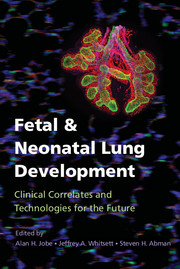Book contents
- Fetal and Neonatal Lung Development
- Lung Growth, Development, and Disease
- Fetal and Neonatal Lung Development
- Copyright page
- Contents
- Contributors
- Preface
- Chapter 1 The Genetic Programs Regulating Embryonic Lung Development and Induced Pluripotent Stem Cell Differentiation
- Chapter 2 Early Development of the Mammalian Lung-Branching Morphogenesis
- Chapter 3 Pulmonary Vascular Development
- Chapter 4 Transcriptional Mechanisms Regulating Pulmonary Epithelial Maturation:
- Chapter 5 Environmental Effects on Lung Morphogenesis and Function:
- Chapter 6 Congenital Malformations of the Lung
- Chapter 7 Lung Structure at Preterm and Term Birth
- Chapter 8 Surfactant During Lung Development
- Chapter 9 Initiation of Breathing at Birth
- Chapter 10 Perinatal Modifiers of Lung Structure and Function
- Chapter 11 Chronic Neonatal Lung Injury and Care Strategies to Decrease Injury
- Chapter 12 Apnea and Control of Breathing
- Chapter 13 Alveolarization into Adulthood
- Chapter 14 Physiologic Assessment of Lung Growth and Development Throughout Infancy and Childhood
- Chapter 15 Perinatal Disruptions of Lung Development:
- Chapter 16 Lung Growth Through the “Life Course” and Predictors and Determinants of Chronic Respiratory Disorders
- Chapter 17 The Lung Structure Maintenance Program: Sustaining Lung Structure during Adulthood and Implications for COPD Risk
- Index
- References
Chapter 15 - Perinatal Disruptions of Lung Development:
Mechanisms and Implications for Chronic Lung Diseases
Published online by Cambridge University Press: 05 April 2016
- Fetal and Neonatal Lung Development
- Lung Growth, Development, and Disease
- Fetal and Neonatal Lung Development
- Copyright page
- Contents
- Contributors
- Preface
- Chapter 1 The Genetic Programs Regulating Embryonic Lung Development and Induced Pluripotent Stem Cell Differentiation
- Chapter 2 Early Development of the Mammalian Lung-Branching Morphogenesis
- Chapter 3 Pulmonary Vascular Development
- Chapter 4 Transcriptional Mechanisms Regulating Pulmonary Epithelial Maturation:
- Chapter 5 Environmental Effects on Lung Morphogenesis and Function:
- Chapter 6 Congenital Malformations of the Lung
- Chapter 7 Lung Structure at Preterm and Term Birth
- Chapter 8 Surfactant During Lung Development
- Chapter 9 Initiation of Breathing at Birth
- Chapter 10 Perinatal Modifiers of Lung Structure and Function
- Chapter 11 Chronic Neonatal Lung Injury and Care Strategies to Decrease Injury
- Chapter 12 Apnea and Control of Breathing
- Chapter 13 Alveolarization into Adulthood
- Chapter 14 Physiologic Assessment of Lung Growth and Development Throughout Infancy and Childhood
- Chapter 15 Perinatal Disruptions of Lung Development:
- Chapter 16 Lung Growth Through the “Life Course” and Predictors and Determinants of Chronic Respiratory Disorders
- Chapter 17 The Lung Structure Maintenance Program: Sustaining Lung Structure during Adulthood and Implications for COPD Risk
- Index
- References
Summary
The lung evolved to efficiently exchange oxygen and carbon dioxide between the external environment and circulating blood. Because it is an open conduit to the environment, the lung must also maintain tight barrier function, defend against inhaled toxins, and have tremendous repair capacity when injured. Creating, maintaining, and repairing the remarkably complex structure of the lung is controlled by genes that regulate cell autonomous functions and cell–cell interactions. However, many studies have now shown how perinatal environmental factors can also permanently modify lung development, thereby influencing long-term lung function and respiratory health. Environmental factors include oxygen at birth, nutrition and intrauterine growth restriction, prenatal and postnatal infections, ionizing radiation, ozone, tobacco smoke, and chemical toxins such as bisphenol A. Although perinatal influences are often considered detrimental to long-term respiratory health, how the lung responds to different levels of oxygen at birth suggests that its response to other influences may represent developmental changes in an organ evolutionarily designed to functionally adapt to its environment. Improving respiratory health as people age may therefore require a better understanding of how the perinatal environment plays a role in generating biologic fit and novelty.
- Type
- Chapter
- Information
- Fetal and Neonatal Lung DevelopmentClinical Correlates and Technologies for the Future, pp. 269 - 285Publisher: Cambridge University PressPrint publication year: 2016



